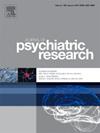脑电图微状态作为非自杀性自伤青年drug-naïve重度抑郁症的生物标志物。
IF 3.2
2区 医学
Q1 PSYCHIATRY
引用次数: 0
摘要
背景:大脑内的静息状态网络表现出稳定和瞬态拓扑结构的动态相互作用,被称为微观状态。非自杀性自伤(NSSI)被认为涉及异常的神经活动和连接。然而,重度抑郁障碍(MDD)伴自伤患者脑电图微状态的具体模式尚不清楚。方法:我们获得了102例drug-naïve重度抑郁症患者的静息状态脑电图(EEG),其中46例有自伤行为,56例无自伤行为,另外还有50名健康对照。采用脑电微状态分析方法,计算了四种不同经典微状态(A-D)的主要指标,包括持续时间、发生时间、时间覆盖范围和过渡概率。结果:与自伤组和非自伤组相比,自伤组显著增加了微状态c的覆盖率。HC组和非自伤组在微状态A和b中的表现相似。HC组的微状态D的覆盖率和持续时间高于MDD患者(自伤和非自伤)。我们还观察到自伤组从微观状态A和D到C的过渡概率增加。在所有MDD患者中,不同时间框架(过去1个月、6个月、1年)的自伤频率与微状态c的覆盖率呈正相关。结论:drug-naïve MDD和自伤行为的年轻成人表现出独特的微状态动态。这些结果表明,脑电图微状态C可能被用作识别重度抑郁症患者自伤的神经生物学标志物。本文章由计算机程序翻译,如有差异,请以英文原文为准。
EEG microstates as biomarkers of drug-naïve major depressive disorder in young adults with non-suicidal self-injury
Background
Resting-state networks within the brain manifest a dynamic interplay of stable and transient topological configurations, recognized as microstates. Non-suicidal self-injury (NSSI) is considered to involve abnormal neural activity and connectivity. However, the specific patterns of EEG microstates in major depressive disorder patients (MDD) with NSSI remain unclear.
Methods
We obtained resting-state electroencephalogram (EEG) from 102 drug-naïve MDD patients—46 with NSSI behavior, and 56 without—alongside 50 healthy controls. Employing the EEG microstate analysis method, we computed the principal indicators for four distinct classic microstates (A-D), encompassing duration, occurrence, time coverage, and transitional probability.
Results
Compared to the HC group and nNSSI group, the NSSI group showed significantly increased coverage for microstate C. The HC and NSSI groups demonstrated similar performances in microstates A and B. Additionally, HCs had higher coverage and duration of microstate D than both MDD patients (NSSI and nNSSI). We also observed heightened transition probabilities from microstates A and D to C in the NSSI group. In all MDD patients, the frequency of NSSI across time frames (past 1 month, 6 months, 1 year) exhibits a positive correlation with the coverage of microstate C.
Conclusion
Young adults with drug-naïve MDD and NSSI behavior exhibit unique microstate dynamics. These results imply that EEG microstates C could potentially be utilized as neurobiological markers to identify NSSI in individuals with MDD.
求助全文
通过发布文献求助,成功后即可免费获取论文全文。
去求助
来源期刊

Journal of psychiatric research
医学-精神病学
CiteScore
7.30
自引率
2.10%
发文量
622
审稿时长
130 days
期刊介绍:
Founded in 1961 to report on the latest work in psychiatry and cognate disciplines, the Journal of Psychiatric Research is dedicated to innovative and timely studies of four important areas of research:
(1) clinical studies of all disciplines relating to psychiatric illness, as well as normal human behaviour, including biochemical, physiological, genetic, environmental, social, psychological and epidemiological factors;
(2) basic studies pertaining to psychiatry in such fields as neuropsychopharmacology, neuroendocrinology, electrophysiology, genetics, experimental psychology and epidemiology;
(3) the growing application of clinical laboratory techniques in psychiatry, including imagery and spectroscopy of the brain, molecular biology and computer sciences;
 求助内容:
求助内容: 应助结果提醒方式:
应助结果提醒方式:


